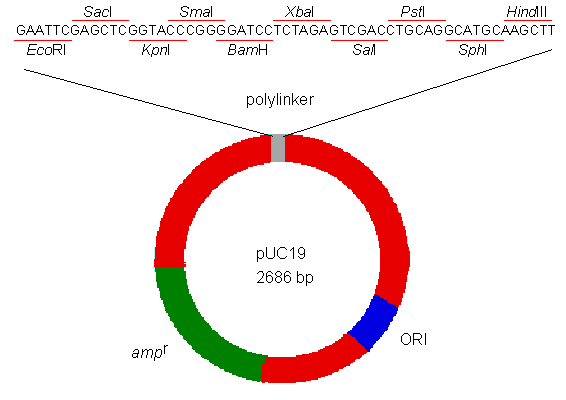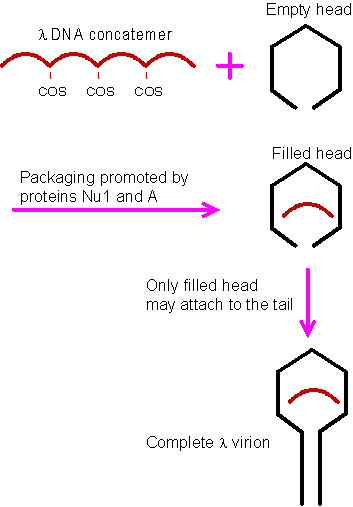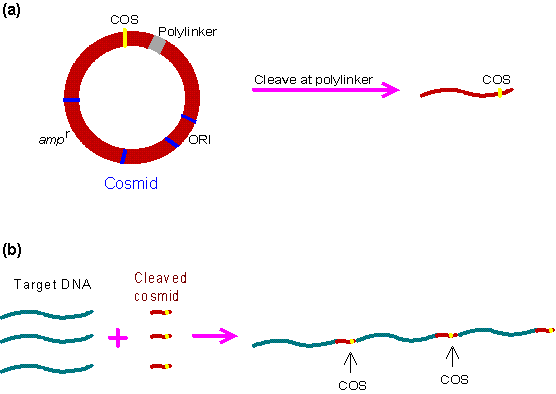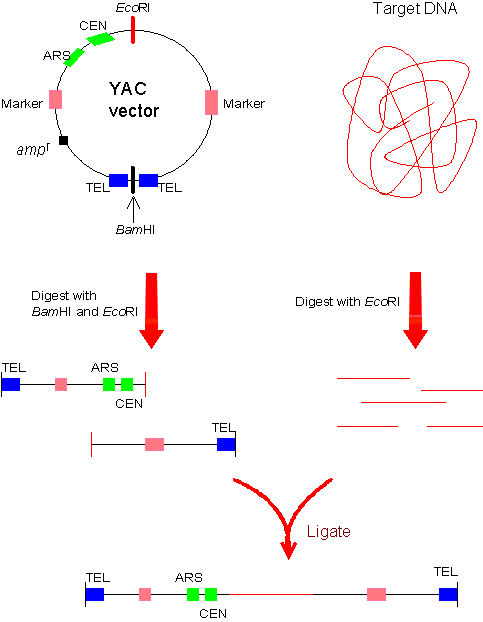
Биотехнология. Векторные молекулы / vectors
.doc|
MoBio Contents |
Cloning Vectors |
|
Chapter 9 |
A | B | C | D | E | F | G | H | I | J | K |
|
|
"Vector" is an agent that can carry a DNA fragment into a host cell. If it is used for reproducing the DNA fragment, it is called a "cloning vector". If it is used for expressing certain gene in the DNA fragment, it is called an "expression vector". Commonly used vectors include plasmid, Lambda phage, cosmid and yeast artificial chromosome (YAC).
Plasmid Plasmids are circular, double-stranded DNA molecules that exist in bacteria and in the nuclei of some eukaryotic cells. They can replicate independently of the host cell. The size of plasmids ranges from a few kb to near 100 kb (see Plasmid Database at NCBI).
Figure 9-A-3. A typical plasmid vector. It contains a polylinker which can recognize several different restriction enzymes, an ampicillin-resistance gene (ampr) for selective amplification, and a replication origin (ORI) for proliferation in the host cell. A plasmid vector is made from natural plasmids by removing unnecessary segments and adding essential sequences. To clone a DNA sample, the same restriction enzyme must be used to cut both the vector and the DNA sample. Therefore, a vector usually contains a sequence (polylinker) which can recognize several restriction enzymes so that the vector can be used for cloning a variety of DNA samples. A plasmid vector must also contain a drug-resistance gene for selective amplification. After the vector enters into a host cell, it may proliferate with the host cell. However, since the transformation efficiency of plasmids in E. coli is very low, most E. coli cells that proliferate in the medium would not contain the plasmids. Therefore, we must find a way to allow only the transformed E. coli to proliferate. Typically, antibiotics are used to kill E. coli cells which do not contain the vectors. The transformed E. coli cells are protected by the ampicillin-resistance gene (ampr) which can express the enzyme, -lactamase, to inactivate the antibiotic ampicillin. Lambda phage phages are viruses that can infect bacteria. The major advantage of the phage vector is its high transformation efficiency, about 1000 times more efficient than the plasmid vector.
Figure 9-A-5. The assembly process of the virion. The extreme ends of the DNA are known as COS sites, each is single stranded, 12 nucleotides long. Because their sequences are complementary to each other, one end of DNA may base-pair with the other end of a different DNA, forming concatemers. The two ends of a DNA may also bind together, forming a circular DNA. In the host cell, the DNA circularizes because ligase may seal the join of the COS sites. In the assembly process of virions, two proteins Nu1 and A can recognize the COS site, directing the insertion of the DNA between them into an empty head. The filled head is then attached to the tail, forming a complete virion. The whole process normally takes place in the host cell. However, to prepare the virion carrying recombinant DNA, the following in vitro assembly system is commonly used. Proteins Nu1 and A are encoded by the genes in the genome. If the two genes are mutated, DNA cannot be packaged into the pre-assembled head. Because tails attach only to filled heads, the cell will accumulate separate empty heads and tails, which can then be extracted. When the extract is mixed with recombinant DNA and proteins Nu1 and A, the complete virion carrying recombinant DNA will be assembled.
Cosmid The cosmid vector is a combination of the plasmid vector and the COS site which allows the target DNA to be inserted into the head. It has the following advantages:
Figure 9-A-6. Cloning by using cosmid vectors. (a) In addition to ampr, ORI, and polylinker as in the plasmid vector, the cosmid vector also contains a COS site. (b) After cosmid vectors are cleaved with restriction enzyme, they are ligated with DNA fragments. The subsequent assembly and transformation steps are the same as cloning with phages.
YACThe yeast artificial chromosome (YAC) vector is capable of carrying a large DNA fragment (up to 2 Mb), but its transformation efficiency is very low.
Figure 9-A-7. Cloning by the yeast artificial chromosome (YAC) vector. Essential components of YAC vectors
|


 Figure
9-A-4.
Schematic
drawing of the DNA cloning using
phages as vectors. The DNA to be cloned is first inserted
into the
DNA, replacing a nonessential region. Then, by an in
vitro assembly system
(described below), the
virion carrying the recombinant DNA can be formed. The
genome is 49 kb in length which can carry up to 25 kb foreign
DNA.
Figure
9-A-4.
Schematic
drawing of the DNA cloning using
phages as vectors. The DNA to be cloned is first inserted
into the
DNA, replacing a nonessential region. Then, by an in
vitro assembly system
(described below), the
virion carrying the recombinant DNA can be formed. The
genome is 49 kb in length which can carry up to 25 kb foreign
DNA.


